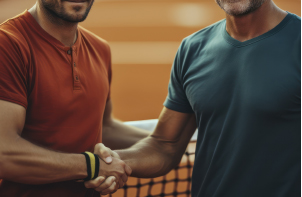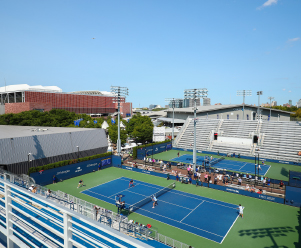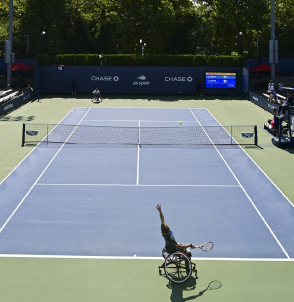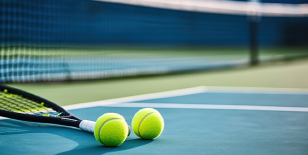TENNIS WELLNESS &
THE
47-WEEK WORKOUT
Why It’s Time to Get Back on the Tennis Court
For many New Yorkers, tennis conjures up iconic images of the U.S. Open – the electric energy of late-summer matches under the lights. Names of my childhood like McEnroe, Connors, Navratilova, King, Evert and Agassi come to mind. For today, Federer, Djokovic, Nadal, Williams and Graf are prevalent. But beyond the glamour of pro play lies an underappreciated truth: tennis is one of the most complete, accessible, and enduring forms of exercise available to people of all ages. At a time when wellness has taken center stage in our fair city, and with the resurgence of racket sports in the cultural ethos, it’s time to reconsider the tennis court not just as a stage for champions, but as a training ground for everyday health.

HE HIDDEN ENGINE BEHIND
AMERICAN TENNIS
While the U.S. Open enjoys the spotlight each September, the real lifeblood of the sport is beating strong the other 47 weeks of the year. At the home of the USTA Billie Jean King National Tennis Center in Queens, programming continues year-round—from junior and senior sessions to adaptive tennis for players with disabilities, birthday parties, seasonal camps, and tournament play.
According to Dale Evans, Director of Tennis Operations, USTA Billie Jean King National Tennis Center, “This infrastructure isn’t just about tennis—it’s about community health.”
Evans continued, “We run every kind of program you can think of—adult leagues, kids’ camps, school break clinics. We are basically the other 47 weeks.”
This consistent programming provides the foundation for what experts are increasingly recognizing as a top-tier sport for both fitness and longevity.

THE FITNESS SECRET
IN PLAIN SIGHT
It turns out, tennis isn’t just fun—it’s one of the healthiest sports in the world. In fact, studies have shown that tennis can increase a person’s average life expectancy by nearly 10 years. That’s a staggering, and very true, figure. According to Evans, the key to this is in the sport’s unique blend of physical demands: anaerobic bursts of speed, agility, balance, and coordination, all packed into an ever-changing rhythm of play.
Each point lasts just 7 to 11 seconds on average. That translates to a series of short, explosive sprints, sharp directional changes, and lightning-fast reflexes. Unlike jogging or steady-state cardio, tennis provides dynamic high-intensity interval training (HIIT) in disguise. The sport engages every muscle group—legs for lateral movement, core for balance, arms and shoulders for serves and overheads, and the brain for constant tactical recalibration.
“Tennis is really a fusion of multiple sports,” said Evans. “You’ve got the throwing mechanics of baseball, the footwork of soccer, the hand-eye coordination of volleyball, and the sprint bursts of basketball. It’s rare to find all those components in a single game.”
Even solo hitting—on a wall or with a ball machine—provides an aerobic and muscular workout that’s accessible to anyone with a racquet and a few spare minutes.

THE SOCIAL MULTIPLIER
Still, it’s not just the physicality of tennis that makes it special—it’s the built-in social structure. Unlike many recreational sports that fall off in adulthood due to logistics or time commitments, tennis adapts. You can rally one-on-one, play doubles, join a local ladder, or just hit against a wall. For New Yorkers, that flexibility is gold. As an example, my Dad, who was a highly successful ad executive and agency owner that traveled most weeks of the year, used to use a backboard at West 91st street playground at the wee hours of the morning. That still allowed him to be at his desk at dawn. Then on weekends, at our country club upstate, he would play against friends, participate in tournaments and doubles matches as well.
“Tennis is a sport where promotions are discussed, marriages are born, and lifelong friendships are formed,” said Evans. “It’s a multi-generational game. You can play with your kids or your grandkids. And unlike team sports like baseball or basketball, you don’t need a full roster—just a partner or a court.”
The USTA’s “Drive for 35” initiative aims to have 35 million Americans playing the sport by 2035. It’s an ambitious goal, but one grounded in the belief that tennis can be more than recreation—it can be a national health solution.
PICKLEBALL VS. TENNIS: THE RACKET RIVALRY
Of course, any conversation about tennis today inevitably brushes up against the very loud rise of pickleball. With its sharp paddle hits and smaller courts, the game has spread rapidly across the country, taking over parks and community centers. For some tennis loyalists, that growth feels like an encroachment. In my humble opinion, pickleball has become a manic and very unhealthy obsession in our city.
“There’s nothing more annoying than trying to play tennis and hearing the pop-pop-pop of pickleball paddles next door,” said a Manhattan resident who plays tennis near a pickleball court and happens to live near one as well. “It’s taken over a lot of the old tennis spaces and the players are as obnoxious as the cyclists in Central Park that don’t heed signs or signals.”
But USTA leaders see the dynamic differently. “Pickleball actually borrowed a lot from tennis’ playbook,” Evsn noted, citing adult league structures, community engagement, and social play. The real difference, they argue, lies in physicality.
“Pickleball is almost entirely lateral—it lacks the forward, backward, and vertical movement that makes tennis a full-body challenge,” he said. “Tennis players sprint, stop, jump, and shift constantly. It’s peaks and valleys of intensity. That’s why the physical benefits are so pronounced.”
Still, both sports offer social value. For those craving more dynamic movement, varied exercise, and longevity-building benefits, tennis retains the edge.

COMING BACK TO THE COURT
For many Gen Xers who grew up watching the McEnroe-Connors rivalry, or even playing at public courts around NYC, the love of the game never faded. What faded was access. With court space in Manhattan limited (and increasingly privatized), and the demands of adult life weighing down, tennis fell off the calendar.
But now, with the wellness conversation shifting toward sustainable lifestyle changes and subtle daily movement, tennis may be ripe for a renaissance.
“There are courts in Central Park, Riverside Park, Queens, Brooklyn—it’s not always easy, but it’s possible,” said Evans. “Even if you only hit once a week, that’s a huge step for your health.”
Programs like Tennis on Campus and adaptive tennis have also opened the game to wider audiences, offering college students and players with disabilities a new way in. For middle-aged New Yorkers, that means more flexibility than ever.
And it doesn’t take much to restart. A racquet. A court. A friend. The only thing missing is you!
SET, MATCH
Tennis isn’t just a sport—it’s a full-body, all-ages, social wellness solution hidden in plain sight. It builds muscle. It boosts brain function. It connects people. And yes, it even adds years to your life.
So, whether you’re picking up a racquet for the first time or dusting one off after a couple of decades, the court is waiting. And with public facilities across the city and new programming rolling out each season, there’s never been a better time to serve up a healthier future.
To learn more about the USTA Billie Jean King National Tennis Center, visit: NTC.USTA.com





